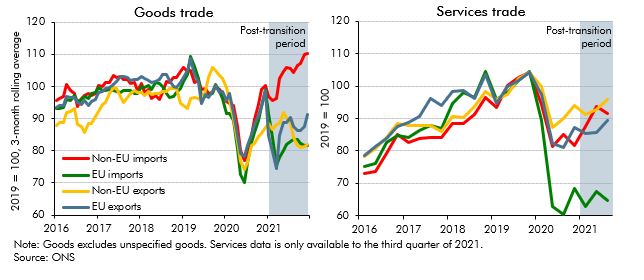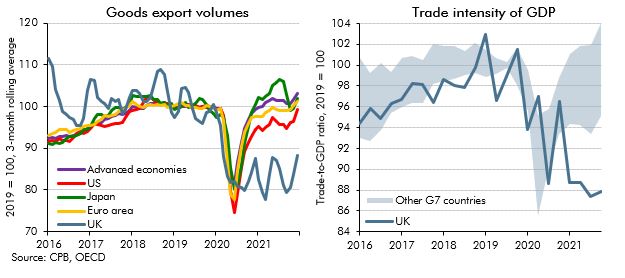In the year following the end of the transition period, overall UK trade volumes fell, although with some surprising compositional effects.
Our March 2022 EFO was published just over a
year since the end of the transition period. In this box, we presented
the latest evidence for the impact of Brexit on UK trade and considered
the UK's recent trade performance relative to other advanced economies.
This box is based on CPB, OECD and ONS data from February and March 2022 .
It
is more than five years since the Brexit referendum, two years since
the UK left the EU, and just over a year since the transition period
ended. Since then, the implementation of the Trade and Cooperation
Agreement (TCA) has proceeded at different speeds on either side of the
Channel. EU countries applied full customs requirements and checks on UK
exports at the start of 2021, while the UK delayed the introduction of
full customs requirements on EU imports until January 2022 and full
health, safety and security checks to the second half of 2022.a
In
the year following the end of the transition period, overall UK trade
volumes fell, although with some surprising compositional effects:
- Goods.
Despite tighter restrictions on the EU side of the border, UK goods
imports from the EU have fallen by more than UK goods exports to the EU
(Chart H, left panel). In the fourth quarter of 2021, goods imports from
the EU were down 18 per cent on 2019 levels, double the 9 per cent fall
in goods exports to the EU. The weakness of EU imports is more striking
compared to the 10 per cent rise in goods imports from non-EU
countries, suggesting some substitution between them. However, there is
little sign to date of UK goods exports to non-EU countries making up
for lower exports to the EU, with the former down 18 per cent on 2019
levels.b
- Services. UK services trade
with the EU has fallen by more relative to 2019 levels than non-EU
trade (Chart H, right panel). However, much of this decline is likely to
reflect the impact of the pandemic, particularly in sectors such as
travel and transport that accounted for a greater proportion of
pre-pandemic EU services trade than non-EU. UK service exports to the EU
and rest of the world have recovered to around 5 and 10 per cent below
2019 levels while imports of services from the EU are still down by over
30 per cent.
Chart H: EU and non-EU goods and services trade

The
seemingly paradoxical weakness in UK imports from the EU relative to
exports to the EU since the end of the transition period is likely the
result of a combination of factors. This could partly relate to rising
prices of energy imports, which are largely sourced from outside the EU.
Some of the apparent substitution between EU and non-EU imports might
also reflect changes in reporting trade flows or goods that always
originated outside the EU no longer passing through the EU on their way
to the UK. Brexit-related effects are likely to include the fact that
the UK is a relatively small market for individual EU exporters, so it
may not be worth the cost of additional paperwork to continue to export
to the UK. One survey shortly after the end of the transition period
found that 17 per cent of German companies had stopped exporting to the
UK, at least temporarily.c Global supply bottlenecks are
likely to have contributed to the weakness in some EU imports, with
machinery and transport equipment accounting for around half of the
import shortfall at the end of 2021 compared to 2019 levels. Stockpiling
likely also boosted EU imports in 2019 before the UK’s departure from
the EU, though imports from the EU are still much lower than even
pre-referendum levels.
Comparing our recent overall trade
performance with other advanced economies suggests that the UK saw a
similar collapse in exports as other countries at the start of the
pandemic but has since missed out on much of the recovery in global
trade.d UK and aggregate advanced economy goods export
volumes fell by around 20 per cent during the initial wave of the
pandemic in 2020. But by the fourth quarter of 2021 total advanced
economy trade volumes had rebounded to 3 per cent above their
pre-pandemic levels while UK exports remain around 12 per cent below
(Chart I, left panel). The UK therefore appears to have become a less
trade intensive economy, with trade as a share of GDP falling 12 per
cent since 2019, two and a half times more than in any other G7 country
(Chart I, right panel).
Chart I: UK and advanced economy trade

While
additional trade with other counties could offset some of the decline
in trade with the EU, none of the agreements concluded to date are of a
sufficient scale to have a material impact on our forecast. The
Government’s own estimate of the economic impact of the free-trade
agreement with Australia, the first to be concluded with a country that
does not have a similar arrangement with the EU,e is that it
would raise total UK exports by 0.4 per cent, imports by 0.4 per cent
and the level of GDP by only 0.1 per cent over 15 years.f
In
summary, there is little in the data since the TCA was implemented to
suggest the assumption of a 15 per cent reduction in trade intensity as a
result of Brexit is no longer a central estimate. But these effects are
likely to take several years to be fully realised, so with only just
over a year having passed since the end of the transition period, and
given the difficulty abstracting from the impact of the pandemic, we
will continue to keep this assumption under review.
OBR
Key

Hover over the blue highlighted
text to view the acronym meaning

Hover
over these icons for more information

Comments:
No Comments for this Article